Samsung's Galaxy S 4: Introduction & Hands On
by Anand Lal Shimpi on March 14, 2013 7:30 PM EST- Posted in
- Smartphones
- Samsung
- Mobile
- Galaxy S 4

Since 2010 Samsung has grown to become not only the clear leader in the Android smartphone space, but the largest smartphone manufacturer in the world. Its annual iteration of the Galaxy S platform is now arguably one of the most widely anticipated smartphone launches each year.
Like clockwork, tonight Samsung announced the Galaxy S 4: a 5-inch 1080p smartphone, and the new flagship for the Galaxy brand. We just finished learning about the device and spent a short time playing around with it.
Most of the hardware specs are known quantities. The 5-inch Super AMOLED display features a 1080p resolution, for a pixel density of over 441 ppi. The chassis is plastic with a metallic looking rim around the edge. Like most Samsung devices, the Galaxy S 4 feels well built although the plastic construction makes it the polar opposite of HTC's One - and truthfully in a different league altogether. I don't personally believe Samsung's use of plastics is terrible, but it definitely doesn't lend itself to the same sort of remarkable designs we see from HTC or Apple. On the plus side the SGS4 feels very light (it's even lighter than the SGS3). The tradeoff between material feel and weight is one that has a spectrum of solutions. Samsung remains on prioritizing weight and cost, which is understandable given the success the company has seen thus far.
The SGS4 feels surprisingly comfortable in hand, partly due to weight and party due to the device's proportions. I didn't mind the size at all.
The Galaxy S 4 is available in two colors: white frost and black mist. I played with an international SGS4 variant in white frost.
| Smartphone Spec Comparison | ||||||
| Apple iPhone 5 | HTC One | Samsung Galaxy S 3 | Samsung Galaxy S 4 | |||
| SoC | Apple A6 1.3GHz | Snapdragon 600 1.7GHz | Snapdragon S4 1.5GHz | Exynos 5 Octa (1.6/1.2GHz) or Snapdragon 600 1.9GHz | ||
| DRAM/NAND/Expansion | 1GB LPDDR2, 16/32/64GB NAND | 2GB LPDDR2, 32/64GB NAND | 2GB LPDDR2, 16/32GB NAND, microSD | 2GB LPDDR3, 16/32/64GB NAND, microSD | ||
| Display | 4.0-inch 1136 x 640 LCD | 4.7-inch SLCD3 1080p, 468 ppi | 4.8-inch Super AMOLED 720p, 306 ppi | 5-inch Super AMOLED 1080p, 441 ppi | ||
| Network | 2G / 3G / 4G LTE Cat 3 | 2G / 3G / 4G LTE Cat 3 | 2G / 3G / 4G LTE Cat 3 | 2G / 3G / 4G LTE Cat 3 (depending on region) | ||
| Dimensions | 123.8mm x 58.6mm x 7.6mm | 137.4mm x 68.2mm x 4mm - 9.3mm | 136.6mm x 70.6mm 8.6mm | 136.6mm x 69.8mm x 7.9mm | ||
| Weight | 112g | 143g | 133g | 130g | ||
| Rear Camera | 8MP | 4MP w/ 2µm pixels | 8MP | 13MP | ||
| Front Camera | 1.2MP | 2.1MP | 1.9MP | 2MP | ||
| Battery | Internal 5.45 Wh | Internal 8.74 Wh | Removable 7.98 Wh | Removable 9.88 Wh | ||
| OS | iOS 6.1.2 | Android 4.1.2 | Android 4.1.2 | Android 4.2.2 | ||
| Connectivity | 802.11a/b/g/n, BT 4.0, USB 2.0, GPS/GNSS | 802.11ac/a/b/g/n + BT 4.0, USB2.0, GPS/GNSS, MHL, DLNA, NFC | 802.11a/b/g/n, BT 4.0, USB 2.0, NFC, GPS/GNSS, MHL | 802.11a/b/g/n/ac (HT80) + BT 4.0, USB 2.0 NFC, GPS/GNSS, IR LED, MHL 2.0 | ||
The back cover remains removable, as does the 9.88Wh battery:
Internally, there’s 2GB of memory and 16 - 64GB of on-board NAND, with a microSD card slot for optional storage expansion.
As expected, the SoC will vary depending on region. Samsung will offer either its own Exynos 5 Octa or a 1.9GHz quad-core Snapdragon SoC from Qualcomm. Given the clock speed and the timing, I would assume Samsung is talking about a Snapdragon 600 but the only official word from Samsung is the 1.9GHz quad-core Snapdragon. Update: Qualcomm has confirmed that this is a Snapdragon 600.
The Exynos 5 Octa side is a bit more interesting. Samsung is calling the SoC a 1.6GHz Octa-core part, but that appears to be the clock speed for the four Cortex A7 cores. The four Cortex A15 cores will run at up to 1.2GHz, which should help keep power consumption manageable. We’ve been wondering for a while what clock speeds we’d see the Cortex A15s run at in smartphones, and I believe this is the first line drawn in the sand. If we go back to Samsung’s ISSCC disclosure of Exynos 5 Octa power consumption, it looks like peak CPU power consumption should be somewhere around 2W - definitely better than what we saw from Exynos 5 Dual in the Nexus 10. Again, no surprises here given that we’re talking about a smartphone - it’s just interesting to see. Update: There seems to be some confusion as to whether or not the A7/A15 clocks are 1.6/1.2 or 1.2/1.6. I was told the former and that's what I wrote down, but it's entirely possible that the information given wasn't correct. I'm awaiting for further confirmation. Although 1.2GHz makes sense for a max clock for the A15s, 1.6GHz is a bit high for A7s if they're truly to be used to keep power consumption down. I can see it working either way.
Samsung isn’t ready to talk specifics about what SoCs will end up in what regions. We weren’t allowed to run any downloaded applications or benchmarks on the hardware at the event, nor were we told what SoCs were used in the demo hardware. Both SoCs should be good choices though.
Similarly, there’s no disclosure on what baseband silicon is being used although LTE support will be offered depending on the region. It’s highly likely that we’re looking at another MDM9x15 with a discrete applications processor (Snapdragon or Exynos 5 Octa). All of the expected wireless connectivity options are present including 802.11ac and BT 4.0. Samsung is claiming support global LTE roaming (up to six different bands) and FDD/TDD LTE.
As is the norm these days the Galaxy S 4 comes with both a front and rear facing camera. The front facing camera features a 2MP sensor and is capable of recording video at 1080p30. The rear facing camera sees a move to a 13MP sensor with flash. No word on the max aperture or focal length of the camera systems at this point.
The Galaxy S 4 will ship with Android 4.2.2. It will be available both internationally and in the US starting sometime in Q2 (Update: first shipments will be in April). US operators signed up to carry the Galaxy S 4 are AT&T, T-Mobile, Sprint, Verizon, Cricket and US Cellular.


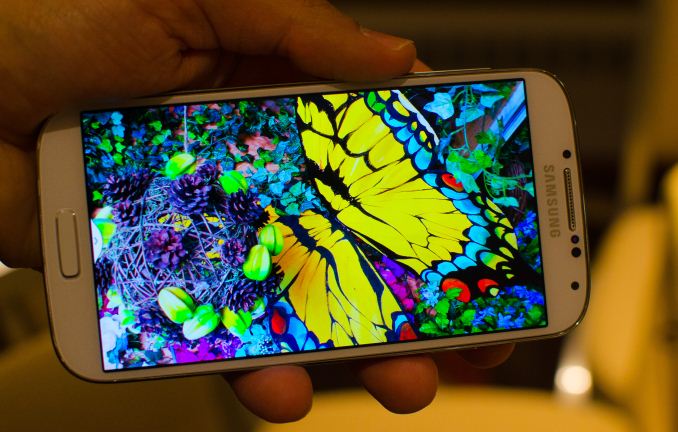
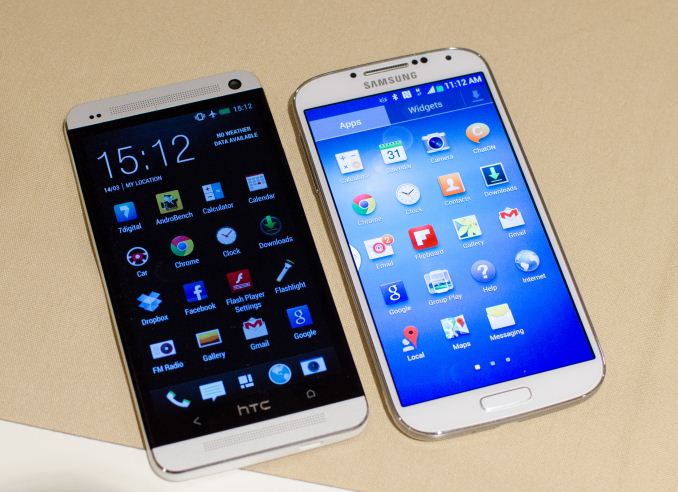

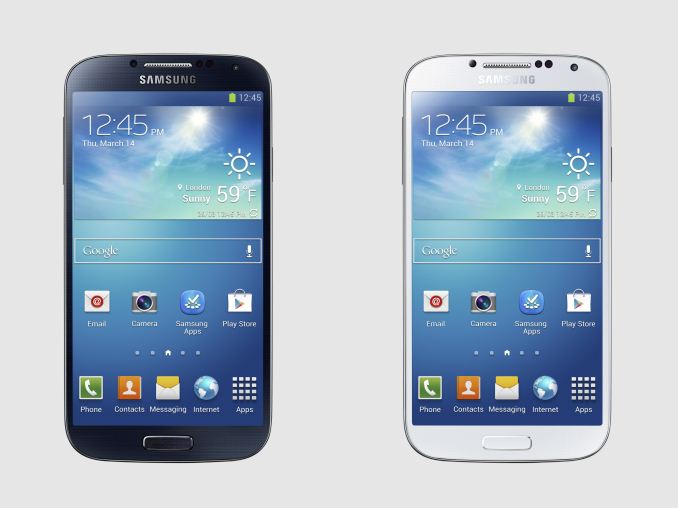
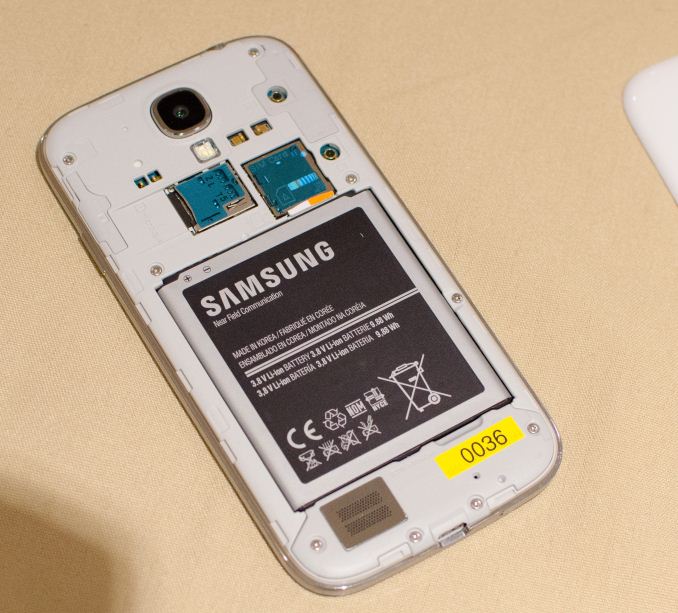
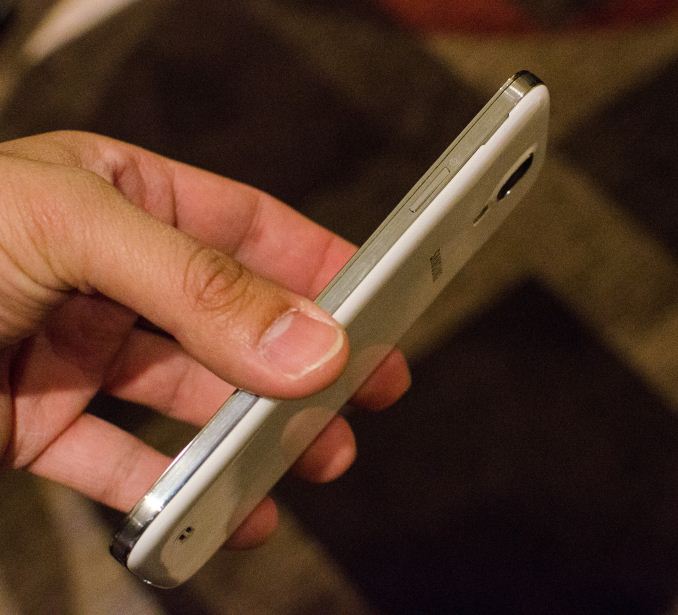















206 Comments
View All Comments
jabber - Friday, March 15, 2013 - link
The reason that Samsung make their phones from plastic isnt just a cost thing. They realised that people tend to drop their phones...a lot!Plastic holds up better to knocks and drops than glass or aluminium. Plus you can always swap your plastic battery cover for a new one if it gets damaged that badly.
doobydoo - Friday, March 15, 2013 - link
Er, sorry but you're wrong. The SG3 fares far worse than the iPhone 5 in every drop test I've seen.Xyfaz87 - Saturday, March 16, 2013 - link
Er, forget about the drop test... I dropped my s3 a lot, and still it is intact and no cracking no dent, only slight scratch, I don't use case also.I don't mind the design of s3, and the choice of plastic. For me I can use it comfortably with one hand, while for xperia Z it looks cool... But I found it awful to hold it for long time with one hand, the more angular design just not my taste.
CeriseCogburn - Saturday, March 16, 2013 - link
It's not just you, anyone with a whit of experience knows sharper edges cut into the meaty part of your hands and fingers and joints, and can be quite painful rather quickly.That doesn't matter though, as the hoi polloi has been exactly trained to spew out ridiculous things like feel of build quality with their internal mental deficit ruling the scoring.
Let them have their butt fugly rectumtangle and let it rip on their digits and give them arthritis as the cold metal and harsh glass guts their tendons.
Since a rectangle with sharp edges and corners is as dumb as it gets, the dorks of the net decided "industrial design" was cool. Yes, it's cool, if you're a basement tard whose never seen the inside of a factory and wouldn't last 2 days in that harsh environment.
Their phones are harsh, sharpened, health hazards, but it's okay the know it all parrots repeat and bleat on cue, no matter what they have ever personally experienced if anything.
Stupid is stupid because stupid does stupid so well, the smartest nerds in the room. ( Cough)
ATBTCT - Sunday, March 17, 2013 - link
Er, actually you are wrong. All the drop tests I have seen of SG3 mostly show damage to the screen only and that is understandable considering that SG3 has a bigger screen compared to iPhone 5. Even if the plastic is damaged it doesn't cost much to change it. Whereas for iPhone and other aluminium clad phones, not only are they not durable as plastic but expensive to repair. And I rarely see expensive flagship without cases. The only ones I see are those that are made up of...................... plastic...I wonder why..............Azurael - Friday, March 15, 2013 - link
Here are some simple yes-or-no questions I would like answered regarding the S3.Brick bug? Y/N
COMPLETE, WORKING Kernel Source & binaries provided Samsung? Y/N
If this is like the SII/Note/S3/Note 2 in having buggy hardware, iffy patches and not even remotely GPL compliant 'developer relations' then they can shove that phone where the sun doesn't shine.
I think it's quite cute that they managed to get A15s in there, I was seriously starting to wonder whether we'd even see A15 in a phone at 32/28nm, let alone a working quad. I can believe it'll only be running at 1.2GHz from what we've seen of A15s power consumption. It still looks as ugly and plasticky as everything else Samsung make too. In fact, it looks the same as the S3 to me, I'm not sure I could tell the difference aside from the larger screen if you put the pair in front of me. If you're going to charge £500 for a device, surely it should look like it cost that?
IKeelU - Friday, March 15, 2013 - link
Agreed. Every Samsung I've handled works just fine, but feels/looks pretty cheap compared to anything by apple or htc (or even the N4, which feels incredible compared to its last two iterations). But a race to the bottom is what the market calls for - artistry and grace be damned. I can't fault Samsung for giving people just enough so they keep coming back.glugglug - Friday, March 15, 2013 - link
So the release is in Q2. Would that be April 1? Because it kind of sounds too awesome to be true.Some of the features (i.e. eye scrolling) sound silly and probably are just battery draining annoyances, but you can turn them off.
I'm hoping the S Translate is limited to translation only, and they didn't override the built-in Android 4.2.2 speech recognition which I've been using for awhile now. Non-cloud for good responsiveness, and the most accurate I've ever seen.
doobydoo - Friday, March 15, 2013 - link
End of April basically. So you could probably get it mid May - 8 months after the release of the iPhone 5.Friendly0Fire - Friday, March 15, 2013 - link
The one element that's *never* covered in any press release or preview is always the one I'm the most curious about: the DAC. I love my Wolfson DAC and having one in the S4 would be a big plus for it, but I've been unable to get any sort of information regarding this anywhere. Even Supercurio doesn't seem to know thus far.Anand, do you have any details or the ability to provide some in the near future?